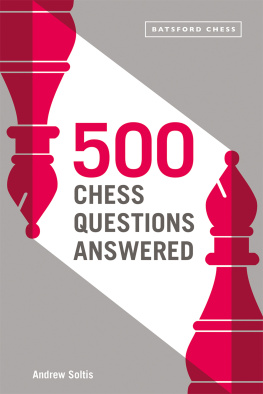More Great Titles from Batsford
tap to read more



 www.anovabooks.com
www.anovabooks.com

First published in the United Kingdom in 2010 by
Batsford
Old West London Magistrates Court
10 Southcombe Street
London
W14 0RA
An imprint of Anova Books Company Ltd
Copyright Batsford 2010
Text copyright Andrew Soltis 2010
The moral right of the author has been asserted.
All rights reserved. No part of this publication may be reproduced, stored in a retrieval system, or transmitted in any form or by any means electronic, mechanical, photocopying, recording or otherwise, without the prior written permission of the copyright owner.
first eBook publication 2013
ISBN 9781849941358
also available as paperback
ISBN 9781906388676
This book can be ordered direct from the publisher at www.anovabooks.com,
or try your local bookshop.
Foreword
Instructional chess books promise a lot. Most promise to make you a better player. Some promise to make you a master if you study the proper techniques.
But very few books say anything about the technique of studying. This leaves the poor student floundering about as he tries to cope with the masses of chess literature and software that confront him. He is deluged with Too Much Information.
The student begins to think that the reason he has difficulty improving is that he doesnt have natural talent or the right computer or books. Or he believes that he cant get much better because he isnt willing to study five, seven or ten hours a day.
But these are not the problems. Every student can improve and improve significantly. What he needs to learn is how to learn.
He needs to find the right methods that will enable him to study more efficiently and productively. These are not sophisticated methods and they do not require you to devote your life to chess. A student needs to make better use of the tools he already has, such as computers and books. He needs to set the right goals, such as how far ahead in a position he should try to visualize. He needs to know how to budget available study time appropriately. Most of all, he needs to make studying chess enjoyable.
Chapter One: Chess isnt school
The reason studying chess is so hard for so many is simple: We make it hard.
We try to study chess the way we were told to study school subjects. We make chess into tedious, mind-numbing homework.
I know. I wasted hundreds of hours studying the wrong way.
I took studying very seriously when I was young. To learn the openings I got a copy of the Bible, as Modern Chess Openings was called. I sat down with a board and pieces and tried to go through it page by page, column by unfathomable column.
On the first page I found a variation of the Four Knights Game that began 1 e4 e5 2  f3
f3  c6 3
c6 3  c3
c3  f6 4
f6 4  b5
b5  b4 5 0-0 0-0 6 d3
b4 5 0-0 0-0 6 d3  xc3 7 bxc3 d6 8
xc3 7 bxc3 d6 8  g5.
g5.
There was only one comment up to there and it said Black could have equalized with 6  d4. I was already confused.
d4. I was already confused.
Why should White play this opening if he has no chance for advantage after six moves, I wondered? And why should Black play anything other than 6  d4 if it equalizes?
d4 if it equalizes?
Not knowing what to make of that, I played through the rest of the page, four columns of recommended play for White and Black. I made notes on sheets of paper, just like in school.
But I had a lot of questions and no answers. It got worse as one of the columns continued 8 h6 9  h4
h4  e7 10
e7 10  d2
d2  d8 11 d4
d8 11 d4  g4.
g4.

I tried to make sense of this as I would an English grammar rule or a math equation. But there were no notes to any of these moves. My list of questions grew longer.
Why does Black retreat his knight to d8 when it wasnt attacked? And what if White plays differently? If I were Black and my opponent played a common sense move like 10  b1 or 10
b1 or 10  e1 instead of the books 10
e1 instead of the books 10  d2 what would I do?
d2 what would I do?
I became more confused as I played through the rest of the column, which continued with increasingly strange moves, such as 12 d5 and then 12  xf3 13 gxf3
xf3 13 gxf3  xe4.
xe4.
The column ended with a string of moves that were a mystery to me, 14  xh6 gxh6 15
xh6 gxh6 15  xe7
xe7  xc3 16
xc3 16  xf8
xf8  xf8 17
xf8 17  c4 b5 18
c4 b5 18 

















 www.anovabooks.com
www.anovabooks.com
 f3
f3  b5
b5  e7 10
e7 10 
 b1 or 10
b1 or 10  xf8 17
xf8 17